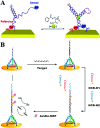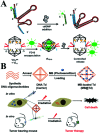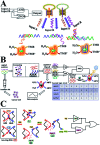Growing prospects of DNA nanomaterials in novel biomedical applications
- PMID: 35516377
- PMCID: PMC9064466
- DOI: 10.1039/c9ra01261c
Growing prospects of DNA nanomaterials in novel biomedical applications
Abstract
As an important genetic material for life, DNA has been investigated widely in recent years, especially in interdisciplinary fields crossing nanomaterials and biomedical applications. It plays an important role because of its extraordinary molecular recognition capability and novel conformational polymorphism. DNA is also a powerful and versatile building block for the fabrication of nanostructures and nanodevices. Such DNA-based nanomaterials have also been successfully applied in various aspects ranging from biosensors to biomedicine and special logic gates, as well as in emerging molecular nanomachines. In this present mini-review, we briefly overview the recent progress in these fields. Furthermore, some challenges are also discussed in the conclusions and perspectives section, which aims to stimulate broader scientific interest in DNA nanotechnology and its biomedical applications.
This journal is © The Royal Society of Chemistry.
Conflict of interest statement
There are no conflicts to declare.
Figures









Similar articles
-
Carbon Nanomaterials and DNA: from Molecular Recognition to Applications.Acc Chem Res. 2016 Mar 15;49(3):461-70. doi: 10.1021/acs.accounts.5b00515. Epub 2016 Feb 23. Acc Chem Res. 2016. PMID: 26907723
-
Preparation, applications, and challenges of functional DNA nanomaterials.Nano Res. 2023;16(3):3895-3912. doi: 10.1007/s12274-022-4793-5. Epub 2022 Aug 31. Nano Res. 2023. PMID: 36065175 Free PMC article. Review.
-
DNA nanomaterials for preclinical imaging and drug delivery.J Control Release. 2016 Oct 10;239:27-38. doi: 10.1016/j.jconrel.2016.08.013. Epub 2016 Aug 13. J Control Release. 2016. PMID: 27527555 Free PMC article. Review.
-
Nanomaterials and DNA multistranded structures: a treasure hunt for targeting specific biomedical applications.J Biomol Struct Dyn. 2023 Dec;41(20):11324-11340. doi: 10.1080/07391102.2022.2159878. Epub 2022 Dec 22. J Biomol Struct Dyn. 2023. PMID: 36546729 Review.
-
DNA Nanotechnology-Enabled Fabrication of Metal Nanomorphology.Research (Wash D C). 2022 Jun 14;2022:9840131. doi: 10.34133/2022/9840131. eCollection 2022. Research (Wash D C). 2022. PMID: 35935136 Free PMC article. Review.
Cited by
-
DNA Origami as Emerging Technology for the Engineering of Fluorescent and Plasmonic-Based Biosensors.Materials (Basel). 2020 May 9;13(9):2185. doi: 10.3390/ma13092185. Materials (Basel). 2020. PMID: 32397498 Free PMC article. Review.
-
Targets and Tools: Nucleic Acids for Surface-Enhanced Raman Spectroscopy.Biosensors (Basel). 2021 Jul 9;11(7):230. doi: 10.3390/bios11070230. Biosensors (Basel). 2021. PMID: 34356701 Free PMC article. Review.
-
Enzymatic synthesis and modification of high molecular weight DNA using terminal deoxynucleotidyl transferase.Methods Enzymol. 2019;627:163-188. doi: 10.1016/bs.mie.2019.07.044. Epub 2019 Aug 30. Methods Enzymol. 2019. PMID: 31630739 Free PMC article.
-
Effect of the Hemin Molecular Complexes on the Structure and Properties of the Composite Electrospun Materials Based on Poly(3-hydroxybutyrate).Polymers (Basel). 2021 Nov 21;13(22):4024. doi: 10.3390/polym13224024. Polymers (Basel). 2021. PMID: 34833324 Free PMC article.
-
Controlled Release in Hydrogels Using DNA Nanotechnology.Biomedicines. 2022 Jan 19;10(2):213. doi: 10.3390/biomedicines10020213. Biomedicines. 2022. PMID: 35203423 Free PMC article.
References
-
- Suo Z. G. Chen J. Q. Hu Z. H. Liu Y. H. Xing F. F. Feng L. Y. Nanofabrication. 2018;4:32–52.
Publication types
LinkOut - more resources
Full Text Sources
Research Materials

